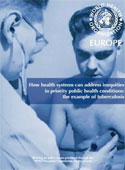How health systems can address inequities in priority public health conditions: the example of tuberculosis

Download
2010, vi + 25 pages
ISBN 978 92 890 4215 4
This publication is only available online.
A knowledge network supporting the WHO Commission on Social Determinants of Health identified 13 priority public health conditions that: lead to a heavy burden of disease, vary widely among and within populations, disproportionately affect certain groups and are prone to epidemics. This booklet uses one of these conditions, tuberculosis (TB) as an example, to show:
– how social determinants cause inequities in exposure to, outcomes of and consequences of TB; and
– how action on these determinants – the “causes of causes” – will reduce inequities and therefore the harm done by TB and other priority public health conditions.
The booklet describes TB in the WHO European Region and how social determinants lead to differences in exposure to up-, mid- and downstream risk factors; vulnerability; health outcomes and consequences. It spells out the implications of these facts for policy: the need for universal social protection systems (using targeting only for populations that fall through the cracks); better primary health care, TB care and other services; intersectoral action for health; and social empowerment and respectful treatment. The booklet concludes by calling for research to increase the evidence base on the causal pathways of the social determinants of TB in Europe and on effective strategies and programmes.
Commissioned by WHO/Europe as part of the WHO/European Commission joint project on equity in health, this is the first of six briefings on policy issues. The project focuses on improving health intelligence and building policy-makers and practitioners’ know-how and capacity to tackle socially determined health inequities as part of health system performance.



